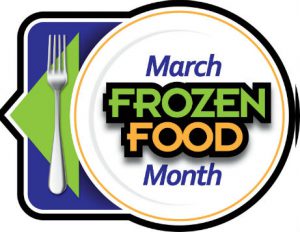March is Frozen Food Month. In fact, the National Frozen & Refrigerated Foods Association (NFRA),Inc., likes to suggest that there is MEALTIME MAGIC in the FROZEN AISLE. I could not agree more!
Frozen foods are a smart choice. Frozen foods are always in season, last much longer than their fresh counterparts, are convenient, economical and full of variety. Plus, frozen foods can be portioned and packaged in ways that don’t leave anything to waste.
A lot has changed since 1925 when Clarence Birdseye was issued U.S. Patent #1,773,079, to freeze fish. This U.S. Patent marked the beginning of today’s frozen foods industry. In 1927, he extended the freezing process to quick-freezing meat, poultry, fruit, and vegetables. Birdseye’s initial introduction of 26 frozen foods has morphed to so many frozen products that the NFRA boasts over 3,700+ different choices. There is something FROZEN for every taste and every budget!
The modern day frozen product is generally supercooled at temperatures below -54°F. This supercooled fast freezing process produces smallish ice crystals that help foods retain their personal characteristics. Additionally, a lot of research goes into commercially frozen food’s packaging. Many frozen products can go directly from freezer to microwave, oven or even a pot of boiling water. Packaging must also consider the constraints of the home freezer knowing that its average temperature is around 0° or a bit below.
Although cold temperatures like 0°F or below puts a temporary hold on many biological processes microorganisms are not always killed off during freezing. It is important to recognize that proper care must be taken preparing some frozen foods.
In addition, when foods are frozen for extended periods of time or are frozen improperly, freezer burn can begin to develop on the food’s surface. Freezer burn happens when moisture in the outer layers of the food evaporates into the dry freezer air, leaving behind empty pockets in the tissue of the food. Freezer burn on meat is visible as brownish-white discolorations and on other foods dry, white spots. While it is not harmful to eat, freezer burn can adversely affect the flavor and texture of food.
It is easy to prevent freezer burn. One can easily reduce the food’s exposure to air through the use of correct wrap before storing food in the freezer. The National Center for Home Food Preservation (https://nchfp.uga.edu/how/freeze.html) has excellent information on how the use of proper packaging materials can protect the flavor, color, moisture content and nutritive value of foods from the arid climate of the freezer.
Frozen food packaging depends on the type of food to be frozen. In general, packaging materials must have certain characteristics:
- Moisture vapor resistant
- Durable and leakproof
- Not become brittle and crack at low temperatures
- Resistant to oil, grease or water
- Protect foods from absorption of off flavors or odors
- Easy to seal
- Easy to mark (with both content and date)
Additionally, a full freezer is the most energy efficient.
Posting a frozen foods inventory (list) near the freezer and keeping it up to date by listing the foods and dates of freezing is helpful. Remembering also to rotate foods in the freezer. An easy acronym for this is FIFO… First-In, First-Out. In other words, use the food stored the longest before you use the newest.
Moreover, purchase a thermometer if your freezer does not have an automatic temperature display. A freezer should be maintained at a temperature of 0°F or lower. At higher temperatures, foods lose quality much faster.
Most recently, a woman from North Carolina, Sheila Pulanco Russell, is credited with bringing a lifehack to the masses with her “how to” Facebook posting. I think it is a good thing to know. It is called the One Cup Tip. All it entails is putting a cup of water in the freezer, freezing it solid, and then placing a quarter on top of it and leaving it in the freezer.
When you return from an extended out of town trip you know if your power was out. It the quarter is sitting at the bottom of the cup you know your power was off too long and that your frozen food is not safe to eat. If the coin is in the middle of the cup, the outage was fairly short and your food should be good (frozen foods that still have their crystals are safe to eat and refreeze). If the coin is still on the top, then there was no power outage or just a quick one and all is well. Note: no one wants food poisoning, so if you are in doubt, throw the food out.
Have questions? Don’t hesitate to call your local county extension agent from the Cooperative Extension office; they’re free!
Heidi Copeland
Family and Consumer Sciences Extension Agent, III
University of Florida IFAS Extension
615 Paul Russell Road
Tallahassee, Florida 32301
hbc@ufl.edu
(850) 606-5203
The Foundation for The Gator Nation
An Equal Opportunity Institution
- It’s Chestnut Season! - December 16, 2022
- Persimmons: Food of the Gods - November 23, 2022
- Have You Ever Thought About Entering Baked Goods in the North Florida Fair? - October 28, 2022

